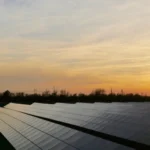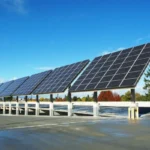Improve Your Power Factor After Solar Installation: Complete Guide
Improve Your Power Factor After Solar Installation: Complete Guide
When we talk about efficient electricity usage, power factor is an important term. Power factor (PF) is the ratio between the real power (the useful power that runs appliances) and the apparent power (the total power supplied by the source). In an ideal world, the power factor would always be 1, meaning there is no wastage. But in reality, it often falls below 1 due to certain electrical characteristics in homes, industries, and even solar setups.

In solar rooftop or ground-mounted systems, power factor becomes a key parameter because it directly affects efficiency and billing. Utilities also monitor PF closely since a low factor means the grid is carrying more load without actually delivering more usable energy. This is why maintaining a good power factor is not just about savings but also about grid stability.
For most cases, solar systems work smoothly without disturbing the power factor. However, in rare scenarios (about 1% of cases), users experience issues where the PF deviates. Understanding why this happens is the first step toward solving it.
Why Power Factor Can’t Always Be Maintained at 1
A lot of people assume that once solar panels are installed, the power factor will remain constant at 1. Unfortunately, this isn’t always the case. Electrical systems are dynamic, and several components can cause PF to fluctuate over time.
One common reason is the type of load connected. Appliances like motors, pumps, air conditioners, and refrigerators create reactive power demand, which reduces the PF. When solar interacts with such loads, the mismatch can show up more clearly.
Another factor is that solar inverters inject active power into the system, but if reactive power from inductive or capacitive loads isn’t balanced, the PF shifts slightly. While this doesn’t always impact performance severely, it is noticeable on monitoring systems or during utility inspections.
So, while a PF of 1 sounds like the ideal target, in practice, it fluctuates depending on usage, wiring, and equipment health.
The Role of CT (Current Transformer) in Power Factor Management
The Current Transformer (CT) plays a critical role in monitoring and maintaining the power factor. CTs measure the current flow and provide inputs to meters and protection systems. If the CT is not sized correctly or if it’s placed at the wrong location in the circuit, it can misread data and give the impression of PF issues.
For example, an undersized CT may not capture the entire current range, leading to incorrect PF values. Similarly, CTs placed too far from the solar inverter or in the wrong section of the panel can pick up noise or partial readings. This can make it seem like PF is disturbed when, in fact, it’s more about CT misalignment.
Regular checking and correct placement of CTs ensure accurate PF readings. This is why electrical audits after installing solar are recommended.
Common Reasons for Power Factor Disturbance After Solar Setup
Capacitor-Related Issues
Capacitors are often installed in systems to correct a lagging power factor. If they are wrongly sized, old, or not serviced, they may not balance the PF properly after solar is added.
Cable Losses (Size or Distance)
If the cables used in wiring are too thin or stretched over long distances, losses increase. These losses not only waste energy but can also cause PF to drop. This is why solar farms use thick and long wires, though they add to costs.
Torquing and Loose Connections
Improperly tightened connections in LT (Low Tension) panels, meters, or distribution boards may cause irregularities in current flow. This irregularity can reflect as a PF disturbance even if the system is fine.
Undersized CT
As mentioned earlier, a small CT cannot handle the load range effectively. This results in inaccurate PF readings, making it a key contributor to PF complaints after solar installations.
Why Solar Sometimes Causes Lagging or Leading Power Factor
Solar systems work with inverters, which convert DC electricity from panels into AC for usage. These inverters are designed to operate at 1 PF, but depending on the type of loads connected, they may show slight lagging (inductive) or leading (capacitive) power factor.
- Lagging PF usually happens when inductive loads like motors or pumps are running.
- Leading PF may occur if capacitors are oversized or if there is a light load with reactive correction equipment still in place.
In most cases, the deviation is very small and doesn’t affect normal operations. However, utilities sometimes impose penalties for consistently low PF, making it important to identify the cause early.
Practical Solutions to Power Factor Issues
Correct CT Sizing and Placement
Always use a CT that matches the load requirements, and place it close to the inverter or distribution point for accurate readings.
Servicing of LT Panels and Equipment
Routine servicing ensures connections are tight, capacitors are functioning, and no hidden faults disturb PF.
One-Time Capacitor Correction
Adding or adjusting capacitor banks helps balance out reactive power, bringing PF closer to 1. This is often a one-time fix with minimal cost.
Regular System Maintenance
Solar systems need periodic checks, not just for panels and inverters but also for electrical components like cables, CTs, and capacitors. This keeps the system efficient and prevents PF issues.
Long-Term Impact of Poor Power Factor on Solar Performance
If the power factor is consistently poor, the system ends up carrying more current than necessary. This increases heating in wires, reduces system efficiency, and can shorten equipment life.
From the billing side, utilities may levy penalties for low PF, which eats into the savings solar promises. Industrial users especially face higher charges when PF is not maintained.
Over time, neglecting PF management can reduce the financial and technical benefits of your solar investment. That’s why small corrections at the right time go a long way in keeping your solar system healthy.
Keeping Your Solar Power Factor in Check
Power factor issues after solar installation are rare but possible. They usually stem from CT sizing errors, capacitor mismatches, or wiring-related losses. The good news is that these problems are easy to fix with professional servicing and minor corrections.
At Smart Roof Solar, we ensure every solar setup is designed with proper PF considerations, from CT placement to capacitor checks. Our expert team doesn’t just install panels; we optimize the entire system for long-term performance.
Ready to install solar without worrying about efficiency issues? Connect with Smart Roof Solar today and make your investment count!
FAQs
Q1. Can power factor impact the lifespan of solar equipment?
Ans: Yes, a poor power factor can cause overheating and stress in cables and devices, reducing the lifespan of the entire system.
Q2. What does ‘apparent power’ include?
Ans: Apparent power combines real and reactive power and is the total power drawn from the source, measured in kVA.
Q3. Can solar systems correct the power factor on their own?
Ans: Most standard inverters operate at 1 PF, but don’t correct PF unless they’re specially designed for it.
Q4. What is the difference between LT and HT panels?
Ans: LT (Low Tension) panels handle low voltage distribution (below 1kV), while HT (High Tension) panels are used for high-voltage supply (above 1kV).
Q5. What is a lagging vs. leading power factor?
Ans: A lagging power factor is caused by inductive loads (like motors), while a leading power factor results from capacitive loads (like capacitor banks).
Suggested Articles

6 Upcoming Renewable Energy Events in India You Should Attend
The World Environment Expo, 2022 is a business platform that allows national and international equipment

1 MW Solar Plant Cost in Haryana | A Complete Guide
Planning a 1 MW solar power plant in Haryana? This guide covers complete 2025 cost details, subsidy schemes, ROI, and savings potential for industrial users.

How a String Monitoring Box Works in Residential Solar Systems
Understand how a string monitoring box helps track and protect your home solar panels for maximum efficiency and safety

Choosing the Right Solar Panel: Complete Guide for India
Solar is among the fastest-growing industries in India. This is mainly because solar energy is not only renewable but is also attractive from a financial point of view.

India Raises Solar Purchase Obligation (SPO) to 8%: A Complete Guide
The Solar Purchase Obligation (SPO) in India is set to increase to 8%, pushing companies to adopt more solar energy. This guide explains the implications for businesses, compliance strategies, and how organizations can align with renewable energy targets.

Selecting Solar Panels: Best Guide for Homes and Factories
Solar panels are a hot topic these days, as the cost of solar is finally approaching what the average family can afford.

Solar Sector Growth in India Slows as Investments Decline in Q1 2023
India’s solar sector experiences an investment slowdown in Q1 2023, reflecting challenges in funding and growth for renewable energy projects.

US Lawmakers Approve Tariffs on Solar Imports from Southeast Asia
US lawmakers vote to restore tariffs on solar imports from Southeast Asia, affecting pricing, supply, and the solar industry landscape.